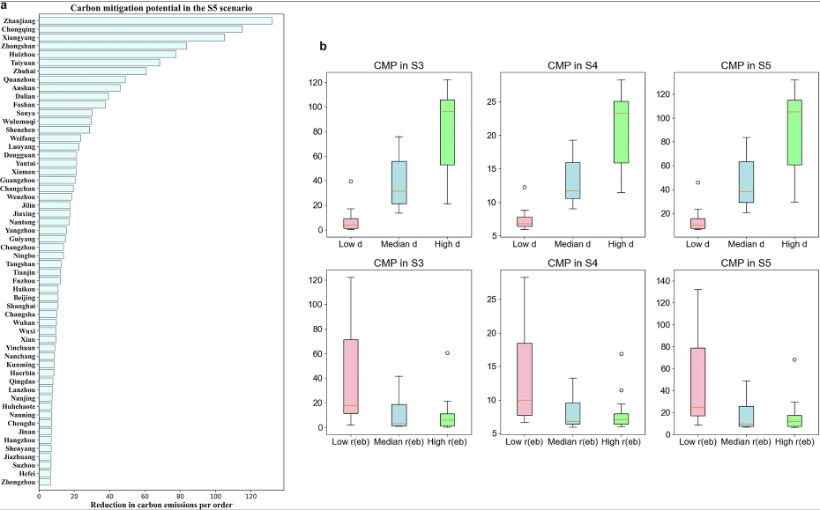The CO2 Footprint of Online Food Delivery
China is tightening its goals to reduce greenhouse gas emissions. Currently, the plans depend on economic growth, but stricter targets need to be implemented. In the past, China often reported environmental successes due to a special calculation method[1] , even while pollution was increasing. As long as emissions did not grow faster than the overall economy, it was considered sufficient.
For the new five-year plan starting in 2026, China, according to plans published last Friday[2] , will focus more on total emission volumes. The current five-year plan, for the world's largest polluter, runs until 2025. The country will not meet its set climate targets due to the aftermath of the COVID-19 pandemic and the global energy crisis, as concluded by the Centre for Research on Energy and Clean Air in a report[3] last year.
A particularly relevant example for urban areas such as Shanghai is a new study[4] examining the CO2 footprint of online food delivery. Online food delivery has become a popular method of food consumption in urban China, driven by the growing popularity of the Online To Offline (O2O) business model. Despite its rapid expansion, the environmental impacts of this industry and its potential for mitigating environmental burdens have not been fully explored in China. New research[5] conducted by Nature revealed that Chinese cities generated 1.67 MtCO2-equivalent (CO2e) from 13.07 billion deliveries in 2019, considering both transport and packaging. Transportation-related greenhouse gas (GHG) emissions were 745 KtCO2e in 2019, averaging 0.057 kg CO2e per order and 0.011 kg CO2e per capita. These emissions have increased from 0.31 MtCO2e in 2014 to 2.74 MtCO2e in 2021, with a projected rise to 5.94 MtCO2e by 2035. However, by implementing policies such as replacing motorcycles with electric bikes and optimising traffic routes, it is possible to reduce GHG emissions by 4.39–10.97 MtCO2e between 2023 and 2035.
The study simultaneously measured and compared the emission reduction potential across different cities, and used the reduction amount of carbon emissions per order as an indicator (see Fig. 1). They present carbon mitigation potential maps for 56 cities, highlighting the top five cities: Zhanjiang, Chongqing, Xiangyang, Zhongshan, and Huizhou. These cities rank among the highest in both the proportion of motorcycles used for deliveries and the delivery distance per order, indicating that cities with long delivery distances and a high proportion of motorcycles have significant carbon mitigation potential.

Figure 1: Carbon mitigation potential (CMP)
Source: https://www.nature.com/articles/s42949-024-00175-8
By analysing carbon mitigation potential based on average distribution distance, they found that cities with longer average delivery distances exhibit higher carbon mitigation potential. In these cities, vehicle electrification offers the highest potential (averaging a reduction of 79.03 g in high-distance cities), followed by optimising traffic routes. Combining these two strategies can achieve an average reduction of 88.54 g in cities with high delivery distances.
From the perspective of carbon emission reduction potential based on the proportion of electric vehicles in the delivery fleet, cities with a higher proportion of electric vehicles demonstrate greater potential for reducing carbon emissions. Vehicle electrification alone can reduce emissions by an average of 40.38 g in cities with lower electric vehicle ratios, while the combination of vehicle electrification and optimised traffic routes achieves an average reduction of 47.70 g in cities with a high proportion of electric vehicles. This study provides a groundbreaking estimate and proposes several strategies for mitigating GHG emissions in China’s urban takeaway delivery industry, which can be especially interesting for a mega city such as Shanghai. To illustrate, as Nature researched that the reduction in carbon emission per order differs per city, it might be beneficial to focus on other forms of reducing GHG emissions related to online delivery. Overall, takeaway delivery is likely to become a popular trend for sustainable urban food systems in the future. However, it must continue to explore methods to reduce environmental impacts, particularly in transportation and packaging. The proposed mitigation strategies focus on improving delivery vehicles and traffic efficiency, but further research is needed to address minimising and reducing unnecessary deliveries. Developing appropriate household social responsibility (HSR) initiatives, such as limiting household takeaway consumption or sharing one delivery among multiple households, could also help reduce carbon emissions.
Thus, China is ramping up its efforts to cut greenhouse gas emissions by shifting its focus from economic growth targets to total emission volumes in the upcoming five-year plan starting in 2026. A new study published in Nature highlights a new area for reduction: emissions related to online delivery. These findings are particularly significant for urban areas like Shanghai. The research indicates that Shanghai has limited capacity to reduce GHG emissions from delivery services, suggesting that alternative reduction strategies might be necessary for the city. Further research is needed to explore Shanghai’s CO2 reduction potential in more detail, responding to the new reduction targets.
Author: Lucy van Eck
Editor: Jonathan Xu
Lucy van Eck is in charge of External Communications at the Benelux Chamber of Commerce. Born in Amsterdam, she has pursued her studies in the United States, Madrid, London, and Shanghai. Recently, she completed a double master's degree in Global Political Economy of China and Europe from the London School of Economics and Fudan University.


